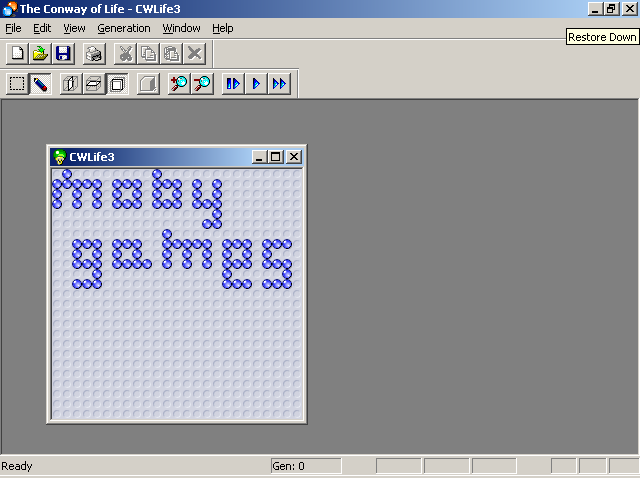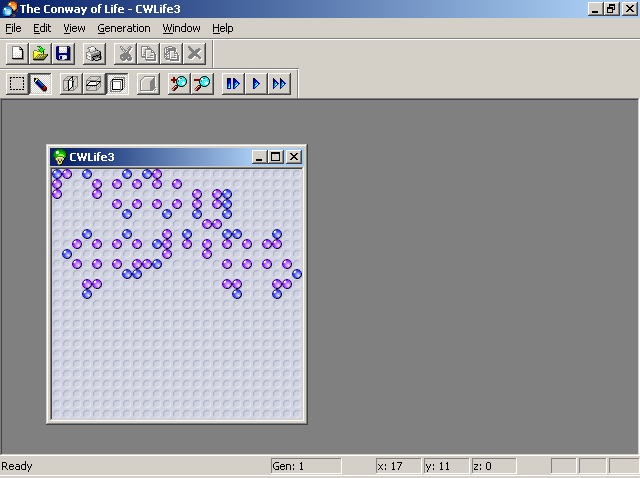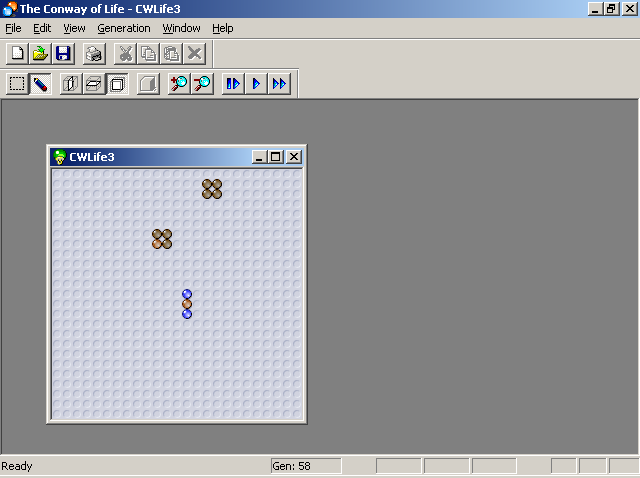Retro Replay Review
Gameplay
Conway’s Game of Life is less of a traditional “game” and more of an open-ended simulation or software toy, in which the player assumes the role of a Newtonian clockmaker god. Instead of guided levels or predefined objectives, you start by placing single-cell “organisms” on a flat, two-dimensional binary grid. Once your initial pattern is set, the true magic unfolds: the simulation advances automatically, applying the classic rules of birth, survival, and death to each cell in discrete time steps.
(HEY YOU!! We hope you enjoy! We try not to run ads. So basically, this is a very expensive hobby running this site. Please consider joining us for updates, forums, and more. Network w/ us to make some cash or friends while retro gaming, and you can win some free retro games for posting. Okay, carry on 👍)
The interactivity lies in experimentation and discovery. You can draw well-known formations—gliders, blinkers, pulsars—or invent your own. Modern implementations often include pattern libraries, random seeding, undo/redo tools, and adjustable simulation speed, enabling you to explore delicate oscillators or rapidly expanding replicators. Watching how a simple arrangement yields complex, sometimes unexpected behaviors can be hypnotic, rewarding curiosity above all.
Rather than fighting enemies or completing missions, you challenge yourself to engineer stable “still lifes,” design perpetual motion machines, or discover self-organizing structures. For educators and hobbyists, the game offers a hands-on way to illustrate concepts in mathematics, computer science, and complexity theory. Each run-through is unique, and the sandbox nature of Conway’s Game of Life invites endless replayability as you refine patterns or stumble upon new emergent phenomena.
Graphics
At its core, Conway’s Game of Life features a minimalist aesthetic: a grid of square cells that toggle between “alive” and “dead” states. While early implementations relied on monochrome displays or even pen-and-paper simulations, modern versions take advantage of high-resolution screens, smooth zooming, and color schemes to differentiate generations, age, or cell groups. You can adjust visuals to your taste—classic black-and-white, vibrant heatmaps, or subtle gradient fades give each iteration its own personality.
The simplicity of the graphics is one of the title’s greatest strengths. Without flashy textures or 3D models, the focus remains on pattern evolution and mathematical beauty. Yet despite its pared-down visuals, the flickering of oscillators and the expansion of glider guns can feel almost painterly. Some platforms even offer bitmap imports or tile-based animations, turning Life into a medium for pixel art that evolves over time.
Performance is rarely an issue, even when simulating grids of millions of cells. Whether you’re running it on a high-end gaming PC or a modest mobile device, the core engine handles rapid updates without stutter. Grid lines can be toggled on or off, and padding or toroidal (“wrap-around”) options allow for infinite-plane illusions. The result is a clean, accessible interface that welcomes newcomers and satisfies seasoned tinkerers alike.
Story
In the strictest sense, Conway’s Game of Life has no narrative arc, characters, or dialogue. Its “story” emerges organically from the interactions of simple rules governing cell survival and creation. Yet in a broader context, the simulation is steeped in a rich mathematical lineage: conceived by John Conway in 1970 and propelled to fame by Martin Gardner’s “Mathematical Games” column in Scientific American, it has inspired generations of computer scientists, artists, and puzzle enthusiasts.
What unites players is the communal thrill of discovery. Early adopters sketched patterns by hand on grid paper or on a Go board; today’s community documents new constructs—worms, breeders, replicators—in online encyclopedias and forums. Each contribution adds to a living tapestry of knowledge, a collective narrative in which your design may become the next celebrated Life “creature.”
This decentralized, player-driven lore is perhaps the most compelling storyline of all. Without scripted events, the game entrusts you with authorship: the life cycles, collisions, and eventual fates of cellular formations become your personal anecdotes. Over time, you compile a mental catalog of famous patterns—the Gosper glider gun, the pulsar, the switch engine—each with its own history, quirks, and delightfully unpredictable behavior.
Overall Experience
Conway’s Game of Life occupies a unique niche between toy, tool, and game. There are no clear “wins” or “losses” beyond what you define for yourself. This freedom can feel liberating or disorienting, depending on your expectations. If you seek a story-driven campaign or competitive multiplayer, you may find Life’s open canvas unfamiliar. But if you appreciate creative experimentation, emergent complexity, and the joy of pattern-spotting, this simulation offers a depth few mainstream titles can match.
For educators and learners, it provides a visually engaging way to explore algorithmic processes, cellular automata theory, and chaos theory. For hobbyists and coders, countless cellular automata variants and scripting interfaces beckon—Life is not merely a closed product but a springboard for custom rule sets, extensions, and cross-disciplinary projects. Many platforms even let you embed Life simulations into websites or network them for distributed experiments.
Ultimately, Conway’s Game of Life is an intellectual playground. Its appeal lies in the tension between simplicity and boundless potential. Whether you want to craft the smallest stable pattern, engineer the largest oscillator, or simply unwind as the simulation runs its course, Life invites you to marvel at how simple rules can produce infinite surprises. If curiosity and creativity are your compass, you’ll find this timeless software toy an endlessly rewarding companion.
 Retro Replay Retro Replay gaming reviews, news, emulation, geek stuff and more!
Retro Replay Retro Replay gaming reviews, news, emulation, geek stuff and more!









Reviews
There are no reviews yet.